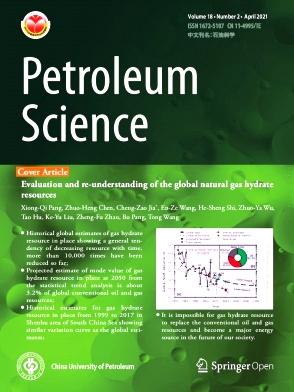Complementary testing and machine learning techniques for the characterization and prediction of middle Permian tight gas sandstone reservoir quality in the northeastern Ordos Basin, China
IF 6
1区 工程技术
Q2 ENERGY & FUELS
引用次数: 0
Abstract
In this study, an integrated approach for diagenetic facies classification, reservoir quality analysis and quantitative wireline log prediction of tight gas sandstones (TGSs) is introduced utilizing a combination of fit-for-purpose complementary testing and machine learning techniques. The integrated approach is specialized for the middle Permian Shihezi Formation TGSs in the northeastern Ordos Basin, where operators often face significant drilling uncertainty and increased exploration risks due to low porosities and micro-Darcy range permeabilities. In this study, detrital compositions and diagenetic minerals and their pore type assemblages were analyzed using optical light microscopy, cathodoluminescence, standard scanning electron microscopy, and X-ray diffraction. Different types of diagenetic facies were delineated on this basis to capture the characteristic rock properties of the TGSs in the target formation. A combination of He porosity and permeability measurements, mercury intrusion capillary pressure and nuclear magnetic resonance data was used to analyze the mechanism of heterogeneous TGS reservoirs. We found that the type, size and proportion of pores considerably varied between diagenetic facies due to differences in the initial depositional attributes and subsequent diagenetic alterations; these differences affected the size, distribution and connectivity of the pore network and varied the reservoir quality. Five types of diagenetic facies were classified: (ⅰ) grain-coating facies, which have minimal ductile grains, chlorite coatings that inhibit quartz overgrowths, large intergranular pores that dominate the pore network, the best pore structure and the greatest reservoir quality; (ⅱ) quartz-cemented facies, which exhibit strong quartz overgrowths, intergranular porosity and a pore size decrease, resulting in the deterioration of the pore structure and reservoir quality; (ⅲ) mixed-cemented facies, in which the cementation of various authigenic minerals increases the micropores, resulting in a poor pore structure and reservoir quality; (ⅳ) carbonate-cemented facies and (ⅴ) tightly compacted facies, in which the intergranular pores are filled with carbonate cement and ductile grains; thus, the pore network mainly consists of micropores with small pore throat sizes, and the pore structure and reservoir quality are the worst. The grain-coating facies with the best reservoir properties are more likely to have high gas productivity and are the primary targets for exploration and development. The diagenetic facies were then translated into wireline log expressions (conventional and NMR logging). Finally, a wireline log quantitative prediction model of TGSs using convolutional neural network machine learning algorithms was established to successfully classify the different diagenetic facies.
用于表征和预测中国鄂尔多斯盆地东北部中二叠统致密气砂岩储层质量的互补测试和机器学习技术
在本研究中,利用适用性互补测试和机器学习技术,介绍了一种用于致密气砂岩(TGSs)成因面分类、储层质量分析和线性测井定量预测的综合方法。该综合方法专门针对鄂尔多斯盆地东北部的中二叠统石河子地层致密气砂岩,由于孔隙度和微达西范围的渗透率较低,该地区的作业者往往面临着巨大的钻井不确定性和更高的勘探风险。本研究利用光学显微镜、阴极荧光、标准扫描电子显微镜和 X 射线衍射分析了碎屑成分和成岩矿物及其孔隙类型组合。在此基础上划分了不同类型的成岩面,以捕捉目标地层中 TGS 的岩石特征。结合 He 孔隙度和渗透率测量、汞侵入毛细管压力和核磁共振数据,分析了异质 TGS 储层的机理。我们发现,由于初始沉积属性和后续成岩改变的不同,不同成岩面之间孔隙的类型、大小和比例存在很大差异;这些差异影响了孔隙网络的大小、分布和连通性,并改变了储层质量。我们将成岩面划分为五种类型:(ⅰ)晶粒包覆面,具有最小的韧性晶粒,绿泥石包覆抑制了石英的过度生长,大的晶间孔隙主导了孔隙网络,孔隙结构最佳,储层质量最高;(ⅱ)石英加固面,表现出强烈的石英过度生长,晶间孔隙度和孔隙尺寸减小,导致孔隙结构和储层质量下降;(ⅲ)混合胶结面,各种自生矿物的胶结增加了微孔,导致孔隙结构和储层质量变差;(ⅳ)碳酸盐胶结面和(ⅴ)致密胶结面,晶间孔隙被碳酸盐胶结物和韧性晶粒充填,因此孔隙网络主要由孔喉尺寸较小的微孔组成,孔隙结构和储层质量最差。储层性质最好的晶粒涂层面更有可能具有高产气性,是勘探开发的主要目标。然后,将成岩面转化为线性测井表达式(常规测井和核磁共振测井)。最后,利用卷积神经网络机器学习算法建立了 TGS 的线性测井定量预测模型,成功地对不同成因面进行了分类。
本文章由计算机程序翻译,如有差异,请以英文原文为准。
求助全文
约1分钟内获得全文
求助全文
来源期刊

Petroleum Science
地学-地球化学与地球物理
CiteScore
7.70
自引率
16.10%
发文量
311
审稿时长
63 days
期刊介绍:
Petroleum Science is the only English journal in China on petroleum science and technology that is intended for professionals engaged in petroleum science research and technical applications all over the world, as well as the managerial personnel of oil companies. It covers petroleum geology, petroleum geophysics, petroleum engineering, petrochemistry & chemical engineering, petroleum mechanics, and economic management. It aims to introduce the latest results in oil industry research in China, promote cooperation in petroleum science research between China and the rest of the world, and build a bridge for scientific communication between China and the world.
 求助内容:
求助内容: 应助结果提醒方式:
应助结果提醒方式:


